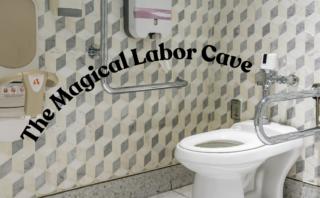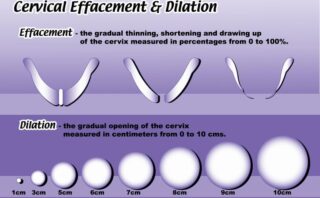Part 2 – Your Options
Here are more details about the different experiences you might have giving birth in a hospital, in-or-out-of-hospital birthing center or in your own home.
What Is It Like to Give Birth in a Hospital?
Here in the US the hospital is the most common site for birth. Maternity care in a hospital is usually led by a physician or a midwife and often reflects the medical mode of care. This can mean that hospital maternity care may:
- Emphasize standardized care rather than individualized care
- Use some health interventions whether or not birthing women need them i.e. electronic fetal monitoring, breaking membranes, cesarean birth
- Rely more on the facility’s technology than your body’s physiology
- Not have staff available to provide continuous physical, emotional and informational support during your labor and birth (many women may be in labor at the same time and the staff might be focused on managing technology
There are some advantages to hospital birth:
- Most childbearing women and newborns are well and healthy. A hospital is best equipped to diagnose and treat those with serious complications or high risk of developing such complications
- You would almost never need to transfer to another facility before, during or after labor except from the rare situations of needing highly specialized care that may not be available in your hospital
- In the rare case of an emergency requiring hospital care, you are at the facility and needed personnel may be immediately available
- You can access some interventions you may want such as epidural pain relief which is not available in other situations
Not all hospitals are alike. They can vary widely in a number of ways, including by:
- “Practice style” that impacts how often they use tests, procedures and drugs – labor induction, cesarean birth, etc.
- Policies and restrictions – limitations on who can be with you; requirement that you use fetal monitoring after admission; not allowing eating or drinking in labor
- Availability of midwifery care
- Stats as a “Level 3” hospital with specialized care for very sick newborns
Because they vary, if you choose to give birth in a hospital, you should choose the one that best meets your needs and is covered by your insurance.
What Is It Like to Give Birth In a Freestanding Birth Center?
Demand for freestanding birth centers is growing and many new ones are being set up. However, they are not yet available in all parts of the United States. This type of care can be a good choice for women who want more personalized care than in hospitals and want to limit use of interventions but don’t feel comfortable with a home birth
In contrast to the institutional environment in hospitals, most freestanding birth centers have a home-like environment and many are, in fact, located in converted homes. Care in birth centers is often provided by midwives and often reflects the midwifery model of care. This means that birth center care may:
- Emphasize individualized rather than standardized care
- Provide care based on what you need and prefer, and avoid the routine use of interventions
- Rely more on your body’s own healthy processes than the facility’s technology. Many types of interventions are less common in birth centers
- Have staff available to give you continuous physical, emotional and informational support during your labor and birth and to support your companions as well (You may be the only one there in labor and the staff is less likely to be focused on managing technology than in hospitals)
There are some drawbacks of birth in out-of-hospital birth centers:
- Most women accepted for birth center care do give birth in this setting. Some switch to hospital care before, during or after labor. This could be because of it being a precaution or due to complications.
- Although freestanding birth centers are situated near hospitals and have established emergency plans, in the rare instance of an emergency requiring hospital care, the hospital facility and personnel are not immediately available. The woman and the baby would need to relocate.
- Although freestanding birth centers offer many “low-tech/high-tech” forms of care, you may wish to have some types of care (such as epidural pain relief) that are not available in freestanding birth centers.
Not all out-of-hospital birth centers are alike. They can vary in a number of ways:
- How often they use tests and procedures
- Policies and restrictions
- Characteristics of back-up hospital and physicians that you’d have access to
- Access to nitrous oxide, which is available in more and more birth centers
Because of this variation, if you choose to give birth in a freestanding birth center, you should choose the one that best meets your needs.
What Is It Like to Give Birth In an In-hospital Birth Center?
Many hospitals realize the demands for the benefits of a birth center or a home-like environment and offer birth centers within the hospital. This may be a good choice if you appreciate the home-like individualized care of a birth center but want emergency care to be available in the same building.
A birth center within a hospital does not necessarily offer the same type of care as a freestanding birth center. Many hospitals call their regular labor and delivery area their “Birth Center”. This may look more like home-like than the rest of the hospital, the care may be more like a routine hospital delivery than you would experience in a freestanding birth center. The organization that accredits out-of-hospital birth centers has also accredited a small number of in-hospital birth centers.
While considering a hospital birth center, you should also learn about the type of care that is offered there. It is important to clarify how, if at all, a hospital’s birth center policies and practices differ from regular hospital care including:
- Availability of midwives during labor
- Availability of continuous support during labor
- Ability to be up and about and using gravity and movement for labor progress without continuous fetal monitoring
- Availability of choice of methods for pain relief (tubs, showers and birth balls can be good choices; nitrous oxide has many benefits among pain medicines
- Policies and restrictions – who can be in the room with you; whether you are able to et or drink; whether you are free to move about
- How often they use certain procedures or tests (intravenous lines, breaking your membranes)
- Situations in which you would be required to relocate to receive standard hospital care
Does the staff have a commitment to the birth center concept, or is the name “birth center” used primarily for marketing purposes?
What Is It Like to Give Birth at Home?
Home birth shares many qualities of birth in freestanding birth centers. In addition, it is your own familiar and private space and you do not have to relocate during labor or after giving birth. Most home birth care providers are midwives offering what has been called the midwifery model of care. This means that birth in your home may:
- Be highly tailored to your needs and preferences
- Avoid the routine use of interventions and their side effects
- Rely more on your body’s own healthy processes than technology
- Enable you to receive continuous physical, emotional and informational support during your labor and birth and offer important support to loved ones who are with you
There are several drawbacks of home birth:
- Some women planning home births switch to hospital care before, during or after labor; a flexible attitude can be helpful
- Although you would have back-up arrangements in place for any expected emergencies, the facility and personnel are not immediately available. True emergencies are rare but do happen
- You may wish to have some types of care – such as pain medications – that are not available in home settings. Not all providers of home birth services are alike about the different types of maternity care providers who may attend a home birth level.
They can vary in a number of ways including:
- Education, experience and credentials
- Style of practice and rates of using tests and procedures
- Policies and restrictions
- Locations and other characteristics of back-up hospital and physicians
Because of this variation, if you choose to give birth at home, you should choose the home birth care provider who best meets your needs. If you plan a home birth, ensure that your care is well integrated into the broader health care system. Ensure that your maternity care provider has established relationships with a doctor and hospital that will provide back-up services if needed.
If you would like more information about prenatal and birth services, set up a complimentary discussion here.





